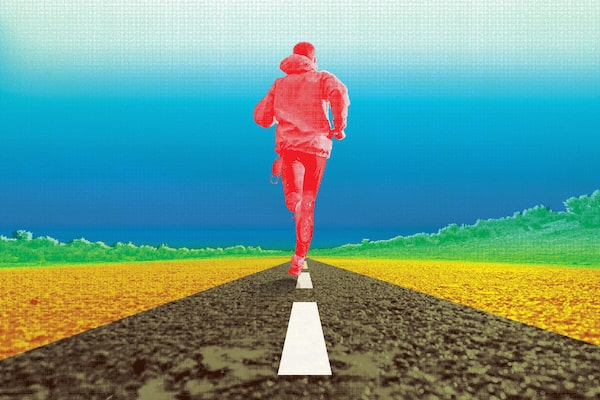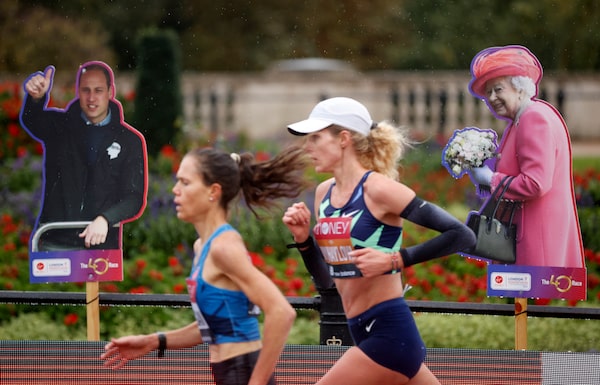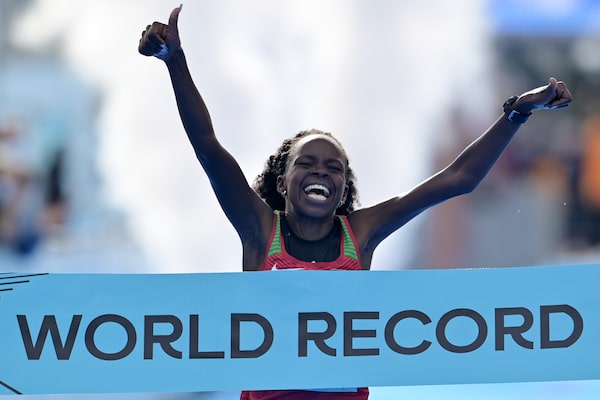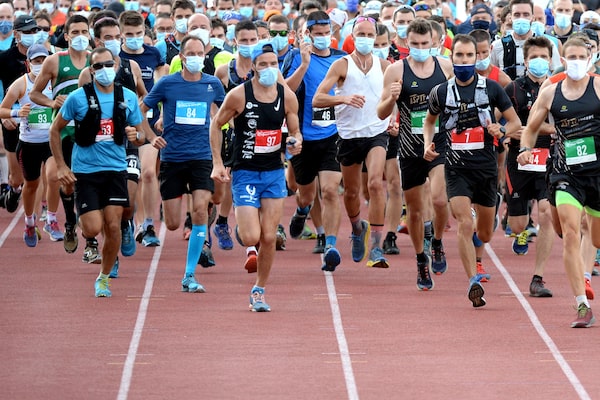
Illustration by Bryan Gee/The Globe and Mail
Alex Hutchinson is a columnist for Outside magazine and a regular contributor to The Globe and Mail. His books include Endure: Mind, Body, and the Curiously Elastic Limits of Human Performance.
Forty-three hours into a race whose brilliantly sadistic format had come to feel like a metaphor for the pandemic itself, Michael Wardian decided to tap out. “I put my hands on my knees and said, ‘No. I don’t want to do this any more,’” he later recalled. The 45-year-old shipbroker from Virginia was one of three runners left in the Quarantine Backyard Ultra, a virtual race in April in which runners had to complete a 4.167-mile loop once every hour – exactly 100 miles every 24 hours – until, well, until they stopped. There was no finish line – the race would end when a single runner was left standing.
Our struggle with COVID-19, we’ve been repeatedly told, is a marathon, not a sprint. But marathons, and even ultramarathons, normally have a clearly defined finish line, no matter how distant. For the 2,400 runners who lined up for the Quarantine Backyard Ultra, streaming via Zoom their lockdown laps around their neighbourhoods (or, in one case, around and around a living room sofa), the open-ended format presented unfamiliar challenges that were logistical at first (how do you pace and fuel yourself for an unknown endpoint?), then motivational and, eventually, existential.
As it happens, there’s a whole subfield of sports science, at the intersection of physiology and psychology, that explores this terrain. It’s called teleoanticipation, a term coined in 1996 by German physiologist Hans-Volkhart Ulmer to describe how our knowledge of an eventual endpoint (or telos) influences the entirety of an experience. Using endurance sports as their medium, researchers in this subfield have probed what happens when you hide the finish line, surreptitiously move it or take it away entirely. For those of us tempted by promising vaccine updates to start fantasizing about an end to the pandemic, these researchers have some advice: don’t.

Runners in Oct. 4's London Marathon pass cardboard cutouts of the Royal Family, stand-ins for the spectators who usually watch the race. The marathon's usual course along the Thames was scrapped due to the pandemic, and instead, an elite group of runners got to compete on a closed-loop course around St. James' Park.John Sibley/Pool via AP/The Associated Press
The standard Aesopian view of pacing – slow and steady wins the race – is based on a simple, mechanistic view of human limits. If you have a certain amount of fuel in the tank and a certain distance to cover, you can calculate how fast to go in order to reach the finish just as your tank runs dry.
But that’s not how humans actually pace themselves. It’s a familiar sight at the local fun run to see runners burst into a sprint as they round the final corner and spot the finish line. This isn’t a sign of inexperience – even the best runners in the world do it, no matter how hard they’ve been pushing. One analysis of a century’s worth of world records over 5,000 and 10,000 metres found that the final kilometre was the fastest of the race 67 per cent of the time and the second-fastest (behind only the opening kilometre) in virtually all other cases. Any discussion of how close you are to being maxed out carries with it an implicit assumption about how close you are to the finish.
The details of exactly how this self-protective circuitry works are still up for debate, but the pattern is deeply ingrained. In Prof. Ulmer’s 1996 paper, he illustrated his ideas with experiments on runners, cyclists and swimmers, but he also speculated about the behaviour of migratory birds, whose long-distance feats had fascinated physiologists for more than a century. The metabolic calculations are enough to give NASA a headache: Eating more allows birds to fly for longer at a stretch, for example, but also costs time and makes them burn more energy in flight owing to the extra weight. The only way birds can successfully weigh all the trade-offs and make the right flight decisions to (just barely) reach their destinations on time is if they have some intrinsic or acquired knowledge of the endpoint.
This fixation on the end creates a somewhat circular sense of what it means to be completely spent. We’re fully drained when we cross the finish line, but it was the act of approaching and crossing the line that did the final draining. Without that anchor, it becomes surprisingly hard to figure out how close we are to our limits.
By the time Mr. Wardian decided to pull the chute in his ultramarathon, his only remaining competitors were a guy on a treadmill in the Czech Republic and a woman in Sweden who had plowed her loop through several feet of snow. With the dawn of a third day of racing still a few hours off, he wandered over to the tent he’d set up outside his house and told his wife, who was crewing for him, that he didn’t want to continue. “That’s not a good excuse,” she replied. He considered it and decided she was right. He headed back out for another lap.
In the lab, teleoanticipation studies confirm that knowing where the finish line is enables you to go faster, mostly because you speed up as the end approaches. This is obvious: If you have a choice between knowledge and ignorance, choose the former. The trickier question is how to handle it when you don’t have a choice.
The natural temptation is to fill the gap by making up an endpoint. In the Quarantine Backyard Ultra, for example, there were 77 runners left as they began the 23rd hour of racing. With the tidy milestone of a full day of racing – 100 miles – approaching, only one runner dropped out after that lap. But more than half the remaining competitors gave up after the 24th or 25th laps. Focusing on that ersatz finish line may have gotten them through some dark hours, but once they passed it, they soon despaired.
Not that I blame them. I remember – hazily, oh so hazily! – when the first Ontario school shutdown was announced in March. It was for the two weeks immediately after March break. As a parent with two young kids, the hassle, the chaos, the sheer magnitude of the disruption seemed inconceivable. But, like holding your breath while you hurry past a bad stench, I knew I could put my life on pause and make it through to the other side.
And when the closing was extended, I knew I could do it again. And again. And again. Each time, though, it became harder to pretend that the end was imminent, and I had to start making adjustments, finding ways to make the situation sustainable instead of putting everything off “until this is all over.” You can only hold your breath for so long.
As the situation seemed to calm down over the summer, sustainability seemed possible. Deep down, I almost managed to convince myself that, in this one solitary respect, Donald Trump was right: The pandemic would some day, “like a miracle,” just disappear.
But with the fall resurgence, as we stare down the barrel of a joyless winter, that fictional finish line is gone for good.

Peres Jepchirchir of Kenya crosses the finish line to win the women's final at Oct. 17's World Athletics Half Marathon Championships in Gdynia, Poland.Adam Nurkiewicz/Getty Images
So how should you approach a race with no finish line? The good news is that letting go of your illusions might actually help.
In studies where, instead of racing, volunteers were asked to run or cycle at a preassigned pace with or without being told how long they would have to maintain that pace, those with no knowledge of the endpoint showed a lower heart rate and reported a lower subjective perception of effort. Their brain activity also shifted away from high-energy executive function regions to the more restful default network associated with daydreaming. When we’re settling in for the long haul, in other words, our bodies and minds make appropriate adjustments.
One particularly interesting study, from University of Essex researcher Dominic Micklewright, outfitted novice and experienced cyclists with an eye-tracking device while they rode a 16-kilometre time trial in order to see what sources of feedback they relied on to pace themselves. The novices looked mostly at their elapsed distance, checking more and more frequently as they approached the finish. The experts looked primarily at their speed, with a frequency that stayed roughly the same throughout the race. In other words, while the novices fixated on the finish and their distance from it, the experts focused on how they were doing right at that moment.
The experiences of professional ultrarunner Diane Van Deren offer a poignant natural experiment suggesting a similar conclusion. Ms. Van Deren only began competing after a brain surgery at the age of 37 left her with permanent damage to her temporal cortex, compromising her ability to keep track of time or distance. What should have been a debilitating handicap for a runner turned out, in the rarefied world of extreme ultradistance racing, to be almost a superpower. “I could be out running for two weeks, but if someone told me it was day one of a race,” she once joked, “I’d be like, ‘Great, let’s get started!’”
It turns out that, if you ask yourself “Can I keep going?” rather than “Can I make it to the finish?” you’re far more likely to answer in the affirmative. That’s the approach the Quarantine Backyard Ultra and events like it force on you.
“The next loop, always the next loop,” French runner Guillaume Calmettes told The Guardian after notching 59 laps in 59 hours to win a similar (but non-virtual) event in 2017. “You’re never overwhelmed by what you have left to run, because you simply don’t know what you have left to run.”

Masked runners take part in the Trail des Moulins in La Pommeray, western France, on Aug. 22. France's initial COVID-19 lockdown had been lifted a few months before this race, but by the fall, a new one would be imposed.JEAN-FRANCOIS MONIER/AFP via Getty Images/AFP/Getty Images
Stay in the moment. It does, admittedly, sound pretty trite when you put it like that. How much can a bunch of semi-deranged endurance junkies really teach us about whether we should risk inviting grandma over for Christmas dinner? Still, the concept of teleoanticipation feels all too pertinent. You can see it in action everywhere, from the rate at which you sneak Halloween candy from your kids' dwindling stash to the halting progress of this essay, which I never would have managed to start without the encroaching finality of a deadline. (I know myself well enough that I resisted asking for an extension until the day before it was due.)
Life itself, if you really want to push it, is one long teleoanticipatory ride. The Buddhist practice of Five Remembrances encourages us to reflect regularly on the unavoidability of our own endpoint. Knowing that the end will come is clarifying; counting the hours until it comes, on the other hand, is paralyzing.
I still follow the vaccine news as closely as the next guy. I’m pulling for Pfizer and Moderna and hoping that Medicago will give us a homegrown option. But the timelines are all over the map. Even if you assume that trials will continue to churn out good news on safety and efficacy, daunting manufacturing and distribution challenges await. I’m not getting invested in next spring or even next fall. Because of all the various scenarios tested in the teleoanticipation literature, the very worst is when you’re about to step off the treadmill at the end of your prescribed bout, only to have the experimenter say, “Ha, just kidding, I need you to keep going for another 10 minutes!” That’s when your perception of how hard things are shoots through the roof. It’s the mismatch between expectation and reality, more than the details of whatever reality you’re dealing with, that really stings.
That’s the epiphany Mr. Wardian had after his wife sent him back onto the course. He reeled off another 19 laps until, at the start of the 63rd hour of racing, his last remaining rival didn’t show up on time for the start. Then he did one more to clinch it. And that, according to the official race rules, was that. Mr. Wardian asked if he could carry on, but the organizers declined. “I was bummed that they said no,” he told Sports Illustrated afterward. “I was like, ‘Drat!’ Because I felt like I was in a good spot, at least at that point, physically and mentally, to be able to push on and go on even further.”
A runner’s remedy
This leg-strengthening exercise takes little time and equipment, but still packs a punch. Trainer Kathleen Trotter shows you how to do it.
Globe and Mail Update
Keep your Opinions sharp and informed. Get the Opinion newsletter. Sign up today.